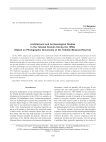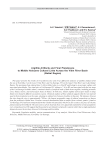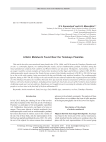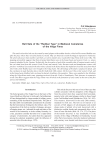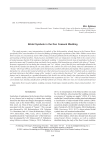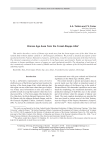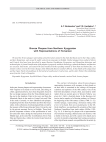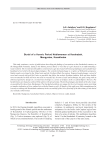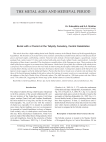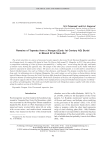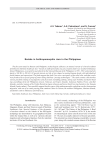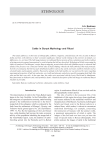Archaeology, Ethnology & Anthropology of Eurasia @journal-aeae-en
Статьи журнала - Archaeology, Ethnology & Anthropology of Eurasia
Все статьи: 524

Armed violence among the Altai mountains pastoralists of the Xiongnu-Sarmatian age
Статья обзорная
Бесплатно
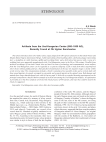
Artifacts from the Ural-Hungarian center (800–1000 ad), recently found at Ob Ugrian sanctuaries
Статья научная
This article introduces four silver dishes and a copper plaque from Ob Ugrian sanctuaries in the Yamal-Nenets and Khanty-Mansi (Yugra) Autonomous Okrugs. A dish representing a bird snatching a fi sh; a dish and a plaque representing deer; a medallion of a dish showing a griffi n and two fl ying birds; and a dish (sliced into pieces) with a scene of a wedding feast were apparently manufactured at the Ural-Hungarian center in the 9th or 10th century. Parallels from medieval workshops of Iran and Central Asia are listed. In terms of technology and ornamentation, seven artifacts from the Ural-Hungarian center can be regarded as a separate subgroup. Each is made from three superimposed silver sheets without gilding and has a thin punched ornamentation on the face (its negative image is clearly visible on the reverse side). The ornamentation includes a border consisting of two parallel arches and a vertical dash with three round imprints of a punch, arranged in a pyramid, and a punch imprint on the animal’s paw. Both humans and animals have large almond-shaped eyes with iris but no pupil. A dish with a scratched drawing superimposed on the principal composition is the fi rst known example of such an item among the Ural-Hungarian artifacts. An explanation is provided as to why those artifacts survived in the ritual practice of Ob Ugrians, and ways they could be used in the ritual are suggested.
Бесплатно
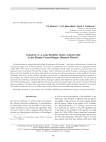
Avtodrom 2-A Late Neolithic (Artyn culture) site in the Baraba forest-steppe, Western Siberia
Статья
Бесплатно
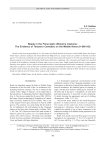
Статья научная
Beads are the most frequent finds in 1st–5th century AD female burials at Tarasovo on the Middle Kama, the largest Finno-Ugric cemetery, dating to the Great Barbarian Migration era. Larger beads are common in burials of women aged 17–45, whereas seed beads were typically worn by girls and young women aged 13–29. This was probably because unmarried girls wore beanies embroidered with beads and bronze ornaments. Also, variously sized beads were attached to bands of the headdress, framing its bottom edges in one or more lines. Single beads found near the crania suggest that they were amulets. In one- and several-strand necklaces, beads alternated with bronze ornaments. Necklaces were often parts of gift sets, some of which are completely preserved, including the organic base. Larger beads were used as pendants. Some of them decorated strips, used for appending knives and other utensils to belts. All these ways of using beads are still practiced by Finno-Ugric women in the Ural area.
Бесплатно
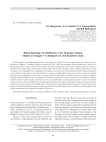
Статья научная
Archaeological and anthropological data concerning two children’s burials representing the early horizon at Boldyrevo-4 kurgan 1, Orenburg Region, excavated in 2019–2020, are presented. Early mounds were covered by a huge kurgan above another, later burial of adults. The entire complex was built by the Yamnaya people at the turn of the early and middle stages of this culture, about 3300–3100 cal BC. Remains of three children, aged about 6, from two graves, were examined. Severe pathological conditions were discovered. The child from burial 3 died of metastatic cancer. Child 1 from burial 4, represented only by a cranium, possibly suffered from scurvy. The oncological condition may have been triggered by a long stay at a smoky hearth or proximity to a metalworking site, since the Yamnaya population of the Southern Urals was engaged in an intense exploitation of copper deposits. In both children’s burials, common elements of the Yamnaya funerary rite were accompanied by certain unusual features. Vessels were similar in form and decoration, but different in manufacturing technique. The organic substances of which the mats under the skeletons were made display certain differences. These features suggest that children belonged to related but separate groups. Children buried under early mounds apparently had a special inherited social status that had an effect on the further construction of the kurgan for members of the elite.
Бесплатно
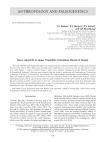
Bony labyrinth in Upper Paleolithic individuals buried at Sungir
Статья научная
The bony labyrinth of the Sungir individuals was studied using the computed tomography scanning on an industrial Phoenix X-ray device. Three-dimensional modeling and visualization were carried out with special software. Crania of an adult (Sungir 1) and two children (Sungir 2 and 3) were analyzed. Findings reveal that bilateral asymmetry is insignificant. Individual variation range suggests that the group is morphologically homogeneous. Comparison of averages with those of Neanderthals and anatomically modern humans demonstrates overall similarity with the latter and significant difference from the former in key traits. Based on results of the discriminant analysis, children unambiguously fall in the H. sapiens group, while the adult is halfway between the latter and the Neanderthal sample. But such a finding is neither exceptional nor even rare. A Neanderthal-like morphology of the bony labyrinth (large lateral semicircular canal and high sagittal index) occurs in a small number of Upper Paleolithic humans of the modern morphological type. The Sungir adult belongs to this group.
Бесплатно
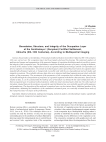
Статья научная
Science-based studies at Gordinskoye I (Guryakar) fortified settlement in northern Udmurtia (9th–13th centuries AD) were carried out. The occupation layer had been largely destroyed by plowing. The statistical analysis of multispectral images and segmentation of the generated images of vegetation distribution make it possible to assess the integrity of the occupation layer. The preliminary conclusion about the presence of its parts, varying in thickness, is based on the analysis of the configuration of areas of segmented multispectral images and the correspondence of diverse segments to relief features. Assessment of archaeological context and of the preservation of occupation layer (superficially disrupted, replaced, or transported) is possible only with the use of geophysical and soil studies and targeted excavations. The available reference data allow us to interpret individual segments present solely on the flat surface of the promontory. The assessment of the parameters of the occupation layer within the entire survey area is possible through the extrapolation of properties of vegetation segments with known characteristics. Based on the totality of data, it can be assumed that the built-up area of Guryakar was limited by the outer fortification line. A thick occupation layer is localized on the promontory, within two inner structural parts of the site. Two other parts of Guryakar, situated between the residence area and the outer fortification line, were probably used for utility purposes and manufacture. The deposition of the medieval occupation layer was less intense there. Additional markers of the fortifications, delimiting the boundaries of the settlement’s structural parts, are vertically oriented linear areas of the transported layer on slopes of the promontory.
Бесплатно
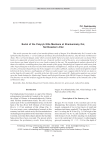
Burial of the Pazyryk elite members at Khankarinsky dol, Northwestern Altai
Статья научная
This article presents the results of an interdisciplinary study of kurgan 30 at Khankarinsky Dol, located on the left bank of the Inya River, 1–1.5 km southeast of Chineta, Krasnoshchekovsky District, Altai Territory (northwestern Altai). This is a Pazyryk kurgan, under which a looted double burial of a male and an adolescent was found. Their heads were apparently oriented toward the east. Along the northern wall of the grave, an accompanying burial of seven horses was found, placed in two rows, heads oriented to the east. The morphological analysis showed all of them to be stallions, resembling those from other mounds of this group. Morphological comparison with horses from other Pazyryk kurgans in the Altai revealed both similarities and differences. Analysis of the grave goods, including iron bits, a bone pipe-shaped bead, tiny bronze daggers in wooden scabbards, a pickaxe, numerous fragments of gold foil from the horse harness, and fragments of Chinese wooden lacquer ware, suggests that the burial was made no earlier than the 4th century BC – possibly in the late 4th to early 3rd century BC. Radiocarbon analysis was carried out at the Tomsk Institute for Monitoring Climatic and Ecological Systems of the SB RAS Center for Isotopic Studies. The funerary rite and the artifacts suggest that kurgan 30 was constructed for members of the nomadic elite of the northwestern Altai.
Бесплатно

